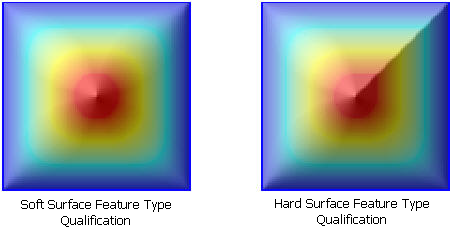Available with 3D Analyst license.
Terrain datasets can be made from different types of data. These include lidar and sonar points, breaklines and points derived from stereo photography, and other forms of survey data. Supported geometry types include points, multipoints, lines, and polygons.
The ability to incorporate a variety of data types into the definition of a surface offers maximum control to sculpt an accurate representation. Surface-specific points capture peaks and pits. Mass points add overall form and control. Breaklines indicate abrupt changes in slope that occur across linear features. Polygons delineate flat areas or areas of no data.
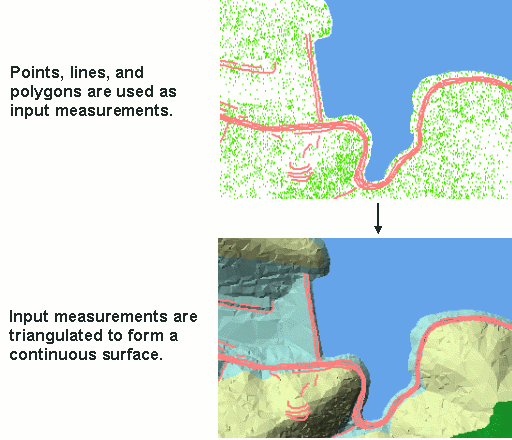
The elevation source for feature geometry can come from the geometry itself or from an attribute. When an attribute is used with either polylines or polygons, it means each feature is flat, since only one z-value can be used per feature.
Types of feature class data sources in terrains
Feature classes provide data sources for building a terrain dataset. As part of terrain dataset design, you establish the role each feature class will play in the terrain and how each data source is used.
Here is a brief review of the surface feature types, or SFTypes, in a terrain dataset.
Mass points
The mass point SFType is used to store many points in one database row. Points are used to record surface specific peaks and pits, as well as provide non-feature specific samples at predetermined minimum spacing to satisfy project accuracy requirements. Many new sensors, such as lidar, can produce huge arrays of mass points that can be used to derive high-resolution terrain datasets. Often, data file formats, such as LAS, can be loaded into multipoint feature classes in the geodatabase, which are subsequently used as data sources for building a terrain dataset. A geoprocessing tool is available to load LAS datasets into the geodatabase.
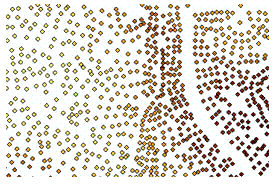
Breaklines
Shown below are breaklines, which are lines with height (z) recorded at each vertex. They become sequences of one or more triangle edges. Breaklines typically represent either natural features, such as ridgelines or streams, or built features, such as roadways.

Clipping polygons
These polygons are used to define boundaries for terrain surfaces. They're needed when a data area has an irregular shape. Without a clip polygon, the data area will be convex. In the graphic below, the terrain on the left is not clipped. The data area is incorrectly represented. Anomalies can be seen where the terrain stretches itself across large areas that have no measurement data. A clip polygon is added to the version on the right, cropping the terrain to the area where measurements were collected.
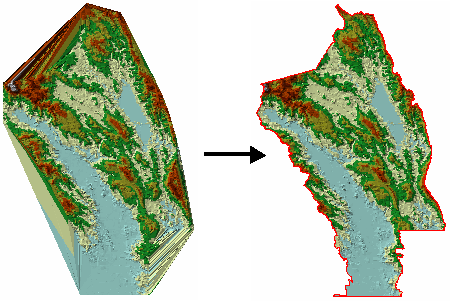
Erase polygons
These polygons define holes in a terrain. These are used to represent areas for which you have no data or want no interpolation to occur. They will display as voids, and analysis will treat them as areas of NoData.
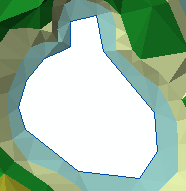
Replace polygons
Replace polygons define areas of constant height. These are typically used to represent water bodies or man-made features that are flat. Replace polygons are best used when other measurements may exist in their interior that have different heights, and you want them reset. If you know there are no contradictory measurements within these areas, add the features as breaklines instead of replace polygons, because there's less work to do in the triangulator and they will be added faster.
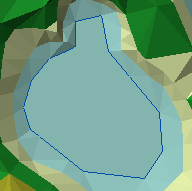
Hard or soft surface feature types
Hard and soft qualifiers for line and polygon feature types are used to indicate whether a distinct break in slope occurs on the surface at their location. This information influences the behavior of the natural neighbors interpolator. It interprets the terrain surface as smooth except when crossing hard lines and hard polygon boundaries. The natural neighbors interpolator is offered by the Terrain to Raster,TIN To Raster, the interactive interpolation tools on the 3D Analyst toolbar, and the Interpolate Shape geoprocessing tool. All the SFTypes other than mass points support the hard or soft qualification.
Some examples of hard features are lake shorelines, streams, building pads, curb lines along roads, and road cuts.
Some examples of soft features are study area boundaries, ridge and valley lines for smooth/rolling topography, void area boundaries, and contours (contours can also be added as mass points).
In the graphic below are two raster surfaces. A raster made from a terrain using the natural neighbors interpolator is shown on the left. All line data in the terrain was added as softlines. The same terrain-to-raster conversion was performed to produce the version on the right; the only difference is a diagonal line in the northeast corner that was added as a hardline to the terrain before rasterization.
